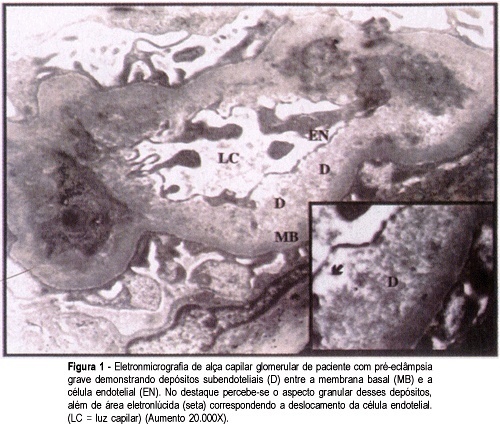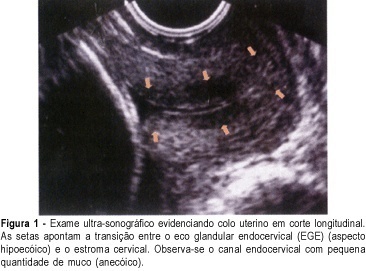Summary
Revista Brasileira de Ginecologia e Obstetrícia. 2004;26(3):221-225
DOI 10.1590/S0100-72032004000300008
OBJECTIVE: to evaluate the presence of curved rods, suggesting Mobiluncus sp, and leukocytosis on Gram and Papanicolaou-stained vaginal smears in cases of bacterial vaginosis. METHODS: two hundred and five vaginal smears were studied by the Papanicolaou's method and other 205 vaginal smears, in the same patients, were evaluated by Gram staining. The diagnosis of bacterial vaginosis was made clinically by one of the authors (J.E.J.) using Amsel's criteria. In the Gram method stained smears the Nugent's score was calculated and the presence of curved rods was evaluated. In Papanicolaou's smears curved rods were searched as well the presence of leukocytes. The data were analyzed by Prism 3.0® with confidence interval of 95% using the Fisher exact test with modified Wald's method. RESULTS: on Pap smears the curved rods were present in 51.7% of the cases. The number of leukocytes varied, although the leukopenia was more frequent. In Gram-stained smears the curved rods were present in 46.8% of the cases and the Nugent's score was 8 in 48.3% of the cases. The finding of Mobiluncus sp in both methods occurred in 82%. When curved rods were observed leukocytosis occurred in 57.5% (p < 0.0001). In the same way, leukocytosis was more frequent in Nugent's scores 9 and 10. CONCLUSION: curved rods were observed in about 52% of bacterial vaginosis. Leukocytosis in Pap smears was more frequent when Mobiluncus sp were found with higher Nugent's scores.
Summary
Revista Brasileira de Ginecologia e Obstetrícia. 2004;26(3):201-206
DOI 10.1590/S0100-72032004000300005
OBJECTIVE: to evaluate platelet parameters in normal and pre-eclamptic pregnant women. METHODS: a controlled cross-sectional study was carried out. The medical records of the women who had delivered in the Hospital Universitário Júlio Müller-Cuiabá/MT, from January 1, 2001 to July 31, 2002, were reviewed. The pregnant women were pre-selected based on their platelet parameters analyses performed after the 28th week of gestation. Two groups of study were analyzed: PE group (36 pre-eclamptic women) and NP group (58 normal pregnant women). The platelet parameters analyzed by the automated method were: platelet counts, mean platelet volume (MPV), platelet distribution width (PDW) and platelet - large cells ratio (P-LCR). For statistical analysis the Student t-test and the chi-square test were used to compare the groups, and to evaluate the degree of dependence among the variables, the coefficient of determination was used (r²). For all these tests, the significance level considered was p < 0.05. RESULTS: the platelet counts did not show difference between the two groups. However, all other platelet indices (MPV, PDW and P-LCR) were significantly higher in the PE group. The severity of the disease was documented in 91.7% of the pre-eclamptic women, despite the fact that none of the patients included had shown thrombocytopenia as a criterion of severity. Negative correlation was detected between the platelet counts and the other platelet parameters analyzed and there was positive correlation between MPV and PDW, MPV and P-LCR, and PDW and P-LCR. Positive correlation was also observed between MPV, PDW and P-LCR, and the maximum systolic and diastolic blood pressures. CONCLUSIONS: pre-eclampsia was associated with these platelet parameters, suggesting alterations of the platelet functions. The clinical applicability of these parameters, as early markers of severity of pre-eclampsia, needs more studies.
Summary
Revista Brasileira de Ginecologia e Obstetrícia. 2004;26(3):185-192
DOI 10.1590/S0100-72032004000300003
PURPOSE: to investigate the glomerular alterations in patients with severe preeclampsia, as well as to evaluate the evolution of these lesions, relating them to the moment of the renal biopsy. METHODS: seventy-two pregnant women with hypertensive syndrome underwent renal biopsy in the puerperium. Appropriate samples for electron microscopic examination were obtained from 39 patients and grouped as follows: 25 with preeclampsia and 14 with superimposed preeclampsia. Biopsy findings were classified into: normal kidney, endothelial cell edema, mesangial expansion, mesangial interposition, subendothelial fibrinoid deposits, and podocyte fusion. RESULTS: the most frequent alterations found in both groups were subendothelial fibrinoid deposits and podocyte fusion. Endothelial edema was present in 84% of the preeclampsia patients and in 92.9% of the superimposed preeclampsia cases. There was no association between the degree of hypertension and the severity of endothelial edema. A tendency to mesangial interposition was observed in patients who had a biopsy after the seventh day after delivery. Podocyte fusion showed a significant association with 24-hour proteinuria. CONCLUSIONS: the above mentioned glomerular alterations represent a spectrum of complex and dynamic lesions that together represent the ultrastructural characteristics of preeclampsia which should no longer be diagnosed based only on the presence or absence of endothelial edema.

Summary
Revista Brasileira de Ginecologia e Obstetrícia. 2004;26(3):193-200
DOI 10.1590/S0100-72032004000300004
PURPOSE: to verify the prevalence of two sonographic findings, the cervical gland area (CGA) feature and the cervical length of less than 20 mm, and to compare these with the risk for premature delivery in pregnant women between 21 and 24 weeks' gestation. METHOD: this was a prospective, cross-sectional study in which 361 women were consecutively examined by transvaginal ultrasonography. Müllerian or other malformations, multiple gestations, fetal death, olygo- or polyhydramnios, marginal placenta previa, and conization, cerclage, amputation or other surgical procedures in the cervix, prior to or during pregnancy, were exclusion criteria. After the abdominal ultrasonographic morphological examination, we used transvaginal ultrasonography to measure the cervical length and to observe the presence of hyper- or hypoechoic area next to the endocervical canal, a feature characteristic of endocervical epithelium glands which is called CGA (cervical gland area). Qualitative variables are expressed as absolute and relative frequency. Quantitative variables are expressed as mean, median, standard deviation, minimum, and maximum values. Association between qualitative variables was detected by the c² test or by the Fisher exact test. For each variable, the relative risk and the 95% confidence interval (CI) were calculated. Logistic regression analysis was used to calculate the predictive values for premature delivery. Significance level was 95% (alpha = 5%), with descriptive (p) values equal or lower than 0.05 considered significant. RESULTS: spontaneous preterm delivery occurred in 5.0% of the patients. Cervical length was up to 20 mm in 3.3% of all studied patients and in 27.8% of those who delivered spontaneously before the end of the pregnancy. Absence of the CGA was detected in 2.8% of all patients and in 44.4% of the women who eventually developed spontaneous preterm labor. There was a statistically significant association of absence of CGA with short cervical length (p<0.001). Absence of CGA was strongly associated with spontaneous preterm delivery (relative risk of 28.57, 95% CI 14.40-56.68). CONCLUSION: the absent CGA feature is a new morphological ultrasonographic parameter that is useful in the prediction of spontaneous preterm delivery in single gestations. Our results show that the parameter can be used as an indicator of risk for premature delivery, to be confirmed by future research.

Summary
Revista Brasileira de Ginecologia e Obstetrícia. 2004;26(3):177-184
DOI 10.1590/S0100-72032004000300002
PURPOSE: to assess the use of antenatal corticosteroid (AC) by mothers and its repercussion on the birth conditions of preterm babies at the eight university neonatal units belonging to the Brazilian Network of Neonatal Research. METHODS: an observational prospective cohort study. All 463 pregnant women with a gestational age (GA) of 23 to 34 weeks and their 514 newborn babies were evaluated during the period from August 1 to December 31, 2001. The data were obtained by maternal interview, by the analysis of the medical records and by the follow-up of the newborn infants, and analyzed statistically using chi2, Mann-Whitney and ANOVA tests and multiple logistic regression, with the level of significance set at 0.05. RESULTS: 60.1% (282/463) of the pregnant women (a variation from 12.5 to 87.3% among units) received at least one AC dose. The AC use was directly associated with the number of prenatal visits, with maternal hypertension and with the antenatal use of tocolytic agents. Babies from treated pregnant women presented higher birth weight (1,379±421 vs 1,244±543 g), longer gestational age (30.9±2.0 vs 29.5±3.5 weeks), better Apgar scores at the 1st and 5th minute, and a reduced need for intervention in the delivery room. The use of AC, the GA and a baby small for GA independently improved the birth conditions. CONCLUSIONS: at most centers, AC was administered at frequencies below the desired ones, and in 50% of cases in an inadequate manner. Treatment was applied more to mothers who received appropriate prenatal care and was associated with better birth conditions.
Summary
Revista Brasileira de Ginecologia e Obstetrícia. 2004;26(2):117-123
DOI 10.1590/S0100-72032004000200006
PURPOSE: to assess the natural pregnancy rates in rabbits submitted to bilateral oophorectomy and orthotopic autologous (both intact and sliced) ovarian transplantation without vascular pedicle and to verify the morphofunctional aspects of reimplanted ovaries. METHOD: thirty-two female New Zealand White rabbits were studied. The ovaries were removed and orthotopically replaced without vascular anastomosis. In the control group (GC) (n=8), only laparotomy was carried out. In the RI group (n=8) intact ovaries were reimplanted in both sides. In the RF group (n=8) the ovaries were sliced and orthotopically reimplanted. In the RIF group (n=8), in one side the intact ovary and in the other side the sliced ovary was reimplanted.Three months later, the animals were paired with sexually mature males for copulation. Estradiol, progesterone, follicle stimulating hormone and luteinizing hormone levels were assessed nine months after surgery. Histologic study of the transplanted ovaries, tubes and uteri was carried out, and the number of pregnancies and animals per litter in each group was taken into account as well. The chi² test compared the pregnancy and the litters between the groups. Student's t test compared the hormone determinations. Significance was set at p<0.05. RESULTS: pregnancies occurred in all rabbits of the GC, between the second and third months after copulation, with 6 to 10 animals per litter for animal. In the other groups, the pregnancies occurred between the fifth and eighth postoperative month. Pregnancies occurred in 37.5% of rabbits in group RI, and in 50% of the RF and RIF groups. There was no difference between the number of animals per litter in the reimplanted groups, with 1 to 4 animals per litter for each animal. Hormone levels and histology confirmed the vitality of all ovaries. CONCLUSIONS: intact or sliced orthotopic autologous ovarian transplantation without vascular pedicle is viable in rabbits, and preserves the hormonal and fertile functions.
Summary
Revista Brasileira de Ginecologia e Obstetrícia. 2004;26(2):139-146
DOI 10.1590/S0100-72032004000200009
PURPOSE: to evaluate whether oral and vaginal sex practice, with or without exposure to semen, decrease the occurrence of recurrent spontaneous abortion. METHOD: this was a case-control study carried out between May 2000 and April 2003. A questionnaire was applied analyzing the clinical, obstetric and sexual history of women, who were divided into two groups: a case group comprised 116 patients with a history of at least two spontaneous abortions, without previous pregnancy longer than 22 weeks, and a control group that included 241 women with history of one or more term pregnancies with live birth and no miscarriage. The analyzed variables included the number of sexual partners, condom use, oral sex practice, and the exposure of female oral mucosa to semen. RESULTS: in the control group 38.8%, and in the patients group 35.7% of the women had only one partner. In both groups about 75% of the women reported that the partners did not use condom. Approximately 55% of the women of both groups referred oral sex practice, and 13.8% of those with recurrent abortion and 20.3% with a history of successful pregnancies had oral mucosa exposed to semen. There was no difference between the patients with recurrent abortion and women with successful pregnancies regarding number of sexual partners, use of condom, practice of oral sex, and exposure of oral mucosa to the partner's semen. CONCLUSION: our results did not confirm the hypothesis that sexual behavior influences the occurrence of spontaneous abortion.